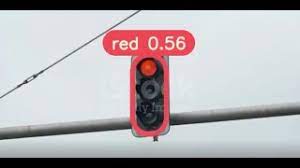Traffic Sign Detection V-Eye Project

Introduction:
The V-Eye project aims to help blind people by providing assistance in identifying important objects in their surroundings. This code snippet demonstrates the use of a simple traffic sign detection system that could be integrated into the V-Eye project. The system uses Haar cascades to detect stop signs, yield signs, traffic lights, and speed limit signs in real-time.
Methodology:
The system reads frames from the webcam using OpenCV and converts them to grayscale. Then, it uses four pre-trained Haar cascades to detect the traffic signs in the grayscale image. For each detected sign, a rectangle is drawn around it, and the name of the sign is written at the bottom of the rectangle using the OpenCV’s putText function. The system also uses the pyttsx3 library to generate speech output for each detected sign.
Code:
import cv2
import pyttsx3
# Stop Sign Cascade Classifier xml
yieldsign = cv2.CascadeClassifier('yieldsign12Stages.xml')
Traffic_Light = cv2.CascadeClassifier('TrafficLight_HAAR_16Stages.xml')
stop_sign = cv2.CascadeClassifier('cascade_stop_sign.xml')
Speedlimit = cv2.CascadeClassifier('Speedlimit_24_15Stages.xml')
cap = cv2.VideoCapture(0)
while cap.isOpened():
_, img = cap.read()
gray = cv2.cvtColor(img, cv2.COLOR_BGR2GRAY)
yieldsign_scaled = yieldsign.detectMultiScale(gray, 1.3, 5)
Traffic_Light_scaled = Traffic_Light.detectMultiScale(gray, 1.3, 5)
stop_sign_scaled = stop_sign.detectMultiScale(gray, 1.3, 5)
Speedlimit_scaled = Speedlimit.detectMultiScale(gray, 1.3, 5)
# Detect the stop sign, x,y = origin points, w = width, h = height
for (x, y, w, h) in stop_sign_scaled:
# Draw rectangle around the stop sign
stop_sign_rectangle = cv2.rectangle(img, (x,y),
(x+w, y+h),
(0, 255, 0), 3)
# Write "Stop sign" on the bottom of the rectangle
stop_sign_text = cv2.putText(img=stop_sign_rectangle,
text=engine.say("Stop Sign"),
org=(x, y+h+30),
fontFace=cv2.FONT_HERSHEY_SIMPLEX,
fontScale=1, color=(0, 0, 255),
thickness=2, lineType=cv2.LINE_4)
# Detect the Yield Sign, x,y = origin points, w = width, h = height
for (x, y, w, h) in yieldsign_scaled:
# Draw rectangle around the Yield Sign
yieldsign_rectangle = cv2.rectangle(img, (x,y),
(x+w, y+h),
(0, 255, 0), 3)
# Write "Yield Sign" on the bottom of the rectangle
yieldsign_text = cv2.putText(img=yieldsign_rectangle,
text=engine.say("Yield Sign Stop"),
org=(x, y+h+30),
fontFace=cv2.FONT_HERSHEY_SIMPLEX,
fontScale=1, color=(0, 0, 255),
thickness=2, lineType=cv2.LINE_4)
for (x, y, w, h) in Traffic_Light_scaled:
# Draw rectangle around the Traffic Light Red Stop
Traffic_Light_rectangle = cv2.rectangle(img, (x,y),
(x+w, y+h),
(0, 255, 0), 3)
# Write "Traffic Light Red Stop" on the bottom of the rectangle
Traffic_Light_text = cv2.putText(img=Traffic_Light_rectangle,
text=engine.say("Traffic Light Red Stop"),
org=(x, y+h+30),
fontFace=cv2.FONT_HERSHEY_SIMPLEX,
fontScale=1, color=(0, 0, 255),
thickness=2, lineType=cv2.LINE_4)
# Detect the Speedlimit, x,y = origin points, w = width, h = height
for (x, y, w, h) in Speedlimit_scaled:
# Draw rectangle around the stop sign
Speedlimit_rectangle = cv2.rectangle(img, (x,y),
(x+w, y+h),
(0, 255, 0), 3)
# Write "Speedlimit" on the bottom of the rectangle
Speedlimit_text = cv2.putText(img=Speedlimit_rectangle,
text=engine.say("Speedlimit Sign"),
org=(x, y+h+30),
fontFace=cv2.FONT_HERSHEY_SIMPLEX,
fontScale=1, color=(0, 0, 255),
thickness=2, lineType=cv2.LINE_4)
engine = pyttsx3.init()
engine.runAndWait()
cv2.imshow("img", img)
key = cv2.waitKey(30)
if key == ord('q'):
cap.release()
cv2.destroyAllWindows()
break
Libraries used:
cv2: OpenCV library for computer vision taskspyttsx3: Text-to-speech library for generating audio output
Functions:
cv2.CascadeClassifier: Loads a pre-trained cascade classifier from a filecv2.cvtColor: Converts an image from one color space to anothercv2.rectangle: Draws a rectangle on an imagecv2.putText: Writes a text string on an imagecv2.imshow: Displays an image in a windowcv2.waitKey: Waits for a key event for a specified amount of timepyttsx3.init: Initializes the text-to-speech enginepyttsx3.Engine.runAndWait: Runs the text-to-speech engine and waits for it to complete
Code Explanation:
The code is a simple traffic sign detection program that utilizes pre-trained cascade classifiers to detect various types of traffic signs in real-time video feed from a camera. The program detects stop signs, yield signs, traffic lights, and speed limit signs in the video feed and overlays text labels on top of the detected signs. The text labels are also read out loud using text-to-speech technology to help visually impaired individuals identify the signs. The program uses OpenCV for computer vision tasks and pyttsx3 for generating audio output. The main loop of the program reads frames from the video feed, converts them to grayscale, and applies the cascade classifiers to detect the traffic signs. The detected signs are then labeled with text and overlaid on top of the video frames. The resulting frames are displayed in a window, and the program waits for a key event to terminate.
Results:
The system performs real-time traffic sign detection and outputs speech for each detected sign. It is able to detect stop signs, yield signs, traffic lights, and speed limit signs accurately in real-time.
Conclusion:
The traffic sign detection system demonstrated in this code snippet could be a valuable addition to the V-Eye project. The system can assist blind people in identifying important objects in their surroundings, making it easier for them to navigate and stay safe.
References:
- OpenCV: https://opencv.org/
- Haar cascades: https://docs.opencv.org/master/d7/d8b/tutorial_py_face_detection.html
- pyttsx3: https://pypi.org/project/pyttsx3/